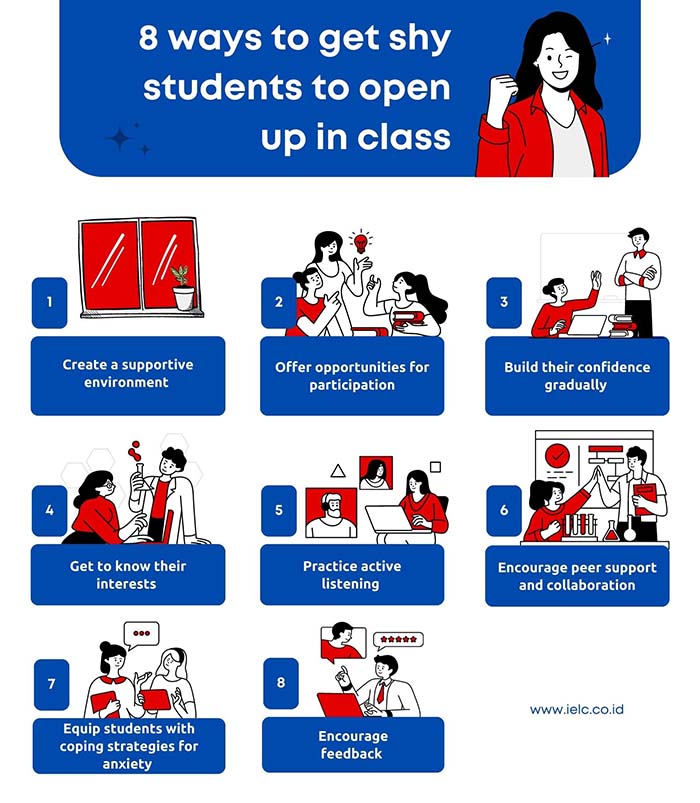
8 ways to get shy students to open up in class
Greetings, educators!
We’re back with another blog post tailored especially for you! Today, our focus is on a challenge that every teacher inevitably encounters: helping shy students come out of their shell.
As we know, every classroom is filled with a wide array of students! Among this colorful array, we often find the quieter ones – the shy students who prefer to stay in the background. Understanding the roots of their shyness is a crucial first step in creating an inclusive learning environment where everyone’s voice is heard.
Let’s start by acknowledging that some students are naturally introverted. Their energy reservoirs are charged by their inner world, and they might find external stimuli, such as bustling classrooms, quite draining.
Unlike their extroverted peers who readily bloom under the spotlight, these introverted learners might choose to observe from the sidelines. It’s not that they aren’t eager to learn or participate, they simply engage with their environment differently!
It’s also recognized that one of the most potent elements in any classroom is peer influence. In the quest to fit in, fear of peer judgment can often deter students from participating fully. The thought of making mistakes or appearing different can seem daunting, causing them to guard their thoughts and ideas.
At times, the silence of shy students may be a symptom of underlying learning or speech difficulties. It’s not merely about finding the courage to share their thoughts, but about the struggle to articulate them correctly. For these students, expressing themselves in class can feel like trying to navigate through an intricate labyrinth.
Moreover, past experiences can cast long shadows. Students who have previously experienced bullying or ridicule may retreat into their shell, dreading the recurrence of such incidents. Instead of viewing the classroom as a safe haven for learning and self-expression, they might see it as a potential battleground.
Identifying these possible causes of shyness gives us a clearer picture of our quieter students’ inner worlds. But remember, every cloud has a silver lining, and every shy student has a voice waiting to be heard. In this blog, we’ll share some tried-and-tested strategies that can help bring these softer voices to the forefront.
So, let’s get started, shall we?

1. Create a supportive environment
The first step to help shy students open up is by creating a classroom environment that feels friendly and inviting. It’s essential to clearly express that every student’s voice is important and contributes to the classroom community.
First thing first, begin by fostering an environment that values and appreciates each individual. Reinforce the idea that mistakes are not something to fear but are an important part of the learning journey. Make sure to create a space where students know it’s okay to make errors – because that’s how we grow and learn!
Additionally, let’s not forget the power of positive reinforcement. Recognize and applaud participation, no matter how big or small. A few words of encouragement can often mean the world to a shy student and can motivate them to participate more often.
Finally, be a role model of the values you want to instill. Show them that it’s perfectly okay to make mistakes and learn from them. You can even share some of your own learning experiences, showing them that we are all lifelong learners, continually growing and improving!
2. Offer opportunities for participation that suits their comfort level
Not all students express themselves in the same way or in the same setting. Some might shy away from speaking up in a room full of classmates, they might prefer to speak up in small groups. It’s about finding the right stage for each student to shine!
Remember, there are many ways for students to share their ideas. For some, written communication might feel more comfortable than speaking out loud. In such cases, activities like journal writing, online discussion boards, or written responses to questions can provide an excellent platform for these students.
Flexibility is key here. As a teacher, your goal is to facilitate learning and engagement, and that often means adapting to the needs of different students. Encourage all forms of participation, and celebrate each student’s unique way of expressing their thoughts and ideas.
3. Build their confidence gradually
Confidence is like a muscle – the more you exercise it, the stronger it gets. For shy students, building confidence can be a journey best taken one step at a time. Setting small, achievable goals can act like stepping stones, gradually leading them towards greater participation and self-assurance.
Begin by setting manageable targets. For instance, a student could initially share their thoughts with just one classmate. This one-on-one interaction can be less intimidating and provide a safe starting point. Celebrate this achievement, then gradually increase the challenge!
Next, encourage them to speak in a small group. As they become comfortable with this, it can slowly pave the way for sharing with larger groups and, eventually, the entire class. The key is to ensure each step feels like a natural progression, not a giant leap.
This might help our students see that they are capable of expressing their thoughts and ideas. Each small success should help fuel their confidence, making the next step seem a little less daunting!
4. Get to know their interests
In my opinion, building rapport and getting to know your students is honestly one of the most important tips for gradually solving all kinds of classroom problems.
Once you understand their interests, it can be easier to engage them in classroom activities. Shy students are more likely to open up and feel comfortable when they realize that their thoughts, interests, and experiences are valued.
Make an effort to learn about their hobbies, their favorite books, sports teams, or anything else that sparks their enthusiasm. This isn’t just about classroom engagement; it’s about showing them that you genuinely care about who they are as individuals!
Once you’ve learned about their interests, weave these into your lessons wherever possible. Perhaps there’s a budding artist; could they illustrate a story as part of a literature lesson? Using their interests as a basis for classroom activities can make learning more relatable and engaging for them.
Remember, when students see their world reflected in the classroom, they feel seen and valued. This can significantly boost their confidence and willingness to participate!
5. Practice active listening
When a quiet student speaks up, it’s a bit like a rare bird singing. It’s important to appreciate these moments and give them your full attention. Active listening isn’t just about hearing their words; it’s about understanding their message and showing that their thoughts are valuable!
When a shy student shares an idea, respond thoughtfully. Show interest, ask follow-up questions, or use their idea as a springboard for further discussion. This doesn’t just validate their contribution, but also encourages other students to listen and respect their peers’ ideas.
If possible, try to weave their ideas into your lessons. This can make them feel valued and show that their participation has a real impact on the classroom.
It’s also important to be patient. Allow them the time they need to express their thoughts without rushing them. Remember, for shy students, the act of speaking up can require a lot of courage. Let them know that they have your attention and that there’s no need to hurry!
6. Encourage peer support and collaboration
A classroom should be more than a place for individual learning; it’s also a platform for building community and forging relationships! Encouraging teamwork can provide a more relaxed and less intimidating environment for shy students to interact with their peers.
Engaging in group tasks often feels less daunting than speaking in front of the whole class. It provides a safe space for them to express their ideas and opinions. And over time, as they build relationships with their peers, they’ll likely feel more comfortable sharing their thoughts in a larger group setting.
Creating a supportive peer environment can also alleviate the fear of judgment or criticism. When students see their peers being supportive and accepting, they are more likely to feel at ease to express themselves. This sense of camaraderie can significantly boost their confidence and willingness to participate.
7. Equip students with coping strategies for anxiety
Shyness can sometimes be rooted in underlying anxiety. To support shy students who may experience anxiety in the classroom, teaching them coping strategies can be immensely beneficial in managing their emotions and building their confidence.
Start by introducing relaxation techniques that can help alleviate anxiety. Deep breathing exercises, where students take slow, deep breaths and focus on their breath, can provide an immediate sense of calm.
Mindfulness exercises, such as guided visualization or body scans, can help students become more aware of their thoughts and sensations, reducing anxiety levels.
Take time to explain the benefits of these techniques and encourage students to practice them regularly. You can incorporate these strategies into daily routines, like starting the class with a brief mindfulness exercise or dedicating a few minutes for deep breathing before challenging activities.
If possible, collaborate with school counselors who can provide additional resources and support for students struggling with anxiety. This collaborative approach ensures a holistic approach to addressing their needs.
8. Encourage feedback
Creating an open and safe communication channel is vital for shy students to feel comfortable expressing their thoughts and concerns. Letting them know that their opinions and feedback are valued can go a long way in building trust and encouraging their participation.
One effective approach is to explicitly communicate to your students that you are open to receiving feedback. Assure them that their input is important and that you genuinely want to hear their thoughts on how to improve the classroom experience. This can be done through casual conversations, class discussions, or even a dedicated feedback box where students can submit anonymous notes.
Anonymous feedback can be particularly beneficial for shy students who may feel hesitant to share their thoughts directly. It gives them the opportunity to voice their opinions without the fear of being singled out or judged. Emphasize that their anonymity will be respected, fostering a sense of safety and trust in their interactions with you.
When you receive feedback, whether it’s anonymous or not, show appreciation for their input. Acknowledge their perspectives and consider incorporating their suggestions into your teaching practices, if appropriate. This demonstrates that their voices truly matter and can have a meaningful impact on the classroom environment!
Summary
Remember, it’s important to approach this issue with empathy and patience. Changes won’t happen overnight, and that’s okay. It’s essential to respect each child’s individuality and pace, as not everyone will become outgoing or extremely participative, and that’s perfectly fine! The goal should be to help students feel comfortable and confident enough to express themselves and participate in a way that feels good to them.
Keep being the hero that your students need. Happy teaching!
Do you want to develop yourself as an educator?
At IELC, we give you the opportunity to join a great team, develop yourself, and make a difference to Indonesia’s future by teaching English the right way to the next generation of English learners.
You will also get access to continuous training and professional development and get to meet fantastic, like-minded colleagues and team members.
Take the first step to enjoy a supportive and fun working environment, develop yourself, and get a rewarding job with IELC.
